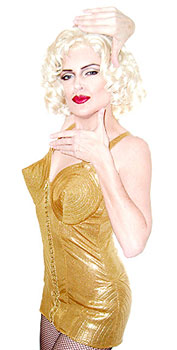Kings of the Wild Frontier: An Analysis of Music-Related Halloween Costumes
Published on September 29th, 2008 in: Halloween, Issues, Music, The Internets, Underground/Cult |By Hanna
Every music nerd knows dressing up is serious business. Halloween is the big night for us to pull out the stops on our [insert favorite obscure artist here] costume, and gives us a chance to show it off outside of gigs and poorly lit clubs in the harsh light of the work and family circle.

Madonna impersonator
Nicole Padberg
I’ve read a lot of deep, academic analysis and criticism, and though studies of youth subculture study music, dress, and so on, they never really specify why the music and the dress are so closely associated with a certain mindset and culture, and frequently the studied group’s other cultural consumption is hardly described or not described at all. Sometimes these studies will talk about big films or books like Rebel Without A Cause, but none of these are given the great importance music is given. Often a critic will feel the need to justify their study of music, as rock ‘n’ roll was thought to be the great harbinger of youth culture. My observations indicate that rather than TV, films, or books, people’s dress is largely defined by the music subculture they identify with.
Though dressing up has always been a large part of any subculture—be it sci-fi fandom, gay culture, or LARP (live action role-playing)—music has the largest influence on casual daywear. With music already shaping people’s everyday fashion, and symbolizing a certain lifestyle and ideology, dressing up as a musician at Halloween is a pretty big statement to make. If you do it right. Just renting a costume does not count; you have to work at it if you wanna hang with the die-hards. Not to mention, if you’re a proper fan, of course you’ll love a rock star so obscure no store will have a costume.
For films, plays, and other such things, costumes are usually designed by a costumier—hard to copy, and with concepts behind them that are hard to grasp for an unschooled person. But with music costumes, it’s different. The kind of costumes that are worn by musicians in quite a lot of genres were developed from the roots up and continue to be. Influenced by gay and drag culture, David Bowie was said to have developed his early 70s costumes from looking at gay kids he saw (or picked up) at the Sombrero Club. The same can be said of T. Rex’s Marc Bolan, who kept a careful look at the other mods and the crowd at the gay clubs he frequented in the mid 60s. Their play with identities and sexuality can be traced back to their imitations of other people by dress.
Since then, it’s been normal for fans to dress up as musicians at gigs, outside of a mutual influence/subculture kind of growth. And like Bowie and Bolan, there continues to be a pretty big drag component there, of course: a lot of girls dressing as male musicians, a lot of men dressing like girly musicians.
Where music costumes are concerned, it’s clearly time to do it yourself, as punk said. The kinds of details fans imitate and work out in their costumes often differ greatly from the originals, and from the costumes of other fans. Yet despite the fact that a lot of people seem to put their collections together from what they have lying around, there are some things that are often a constant in a music-related Halloween costume; there is something gratifying in the way a rock star’s whole image is reduced to a single iconographic item. It is this way with the commercially-sold costumes, too: Elvis is a rhinestone jumpsuit and a wig; Madonna is a cone-y bra and blonde hair; the Spice Girls are Geri Halliwell in a Union Jack dress.
To illustrate my arguments above, I have made a little collection of pictures of costumes I found while Googling for pictures of musicians.
Click to see images of. . .
Time limit is exhausted. Please reload the CAPTCHA.